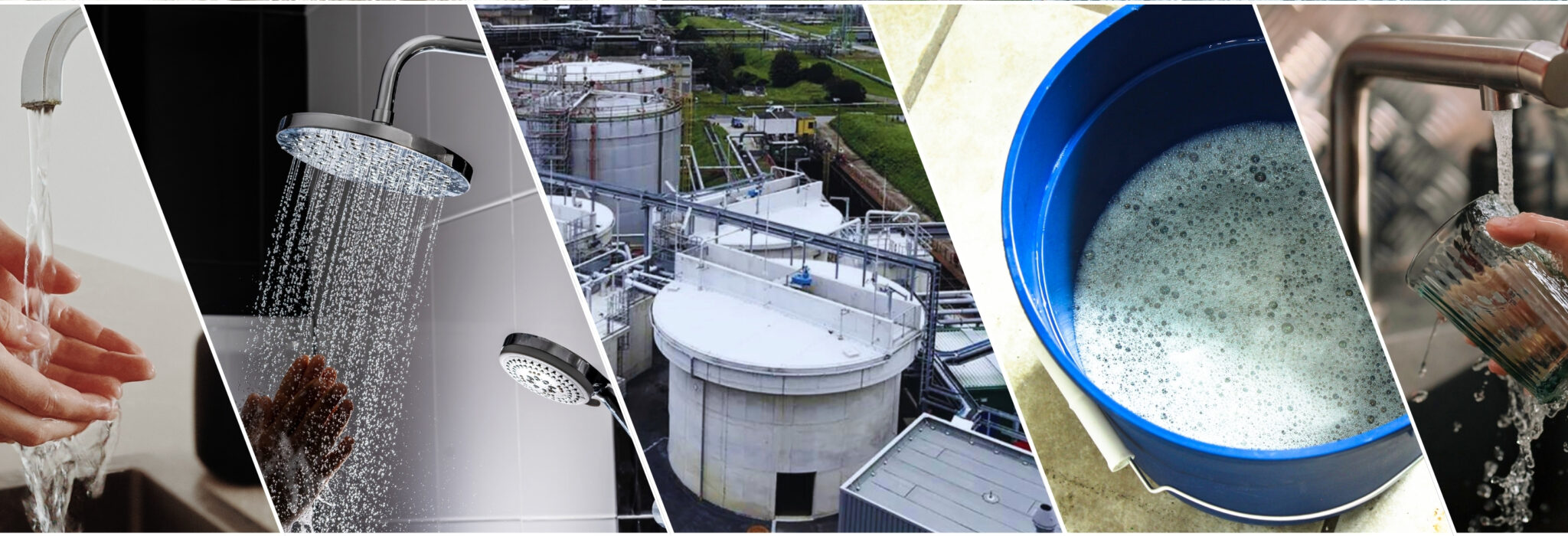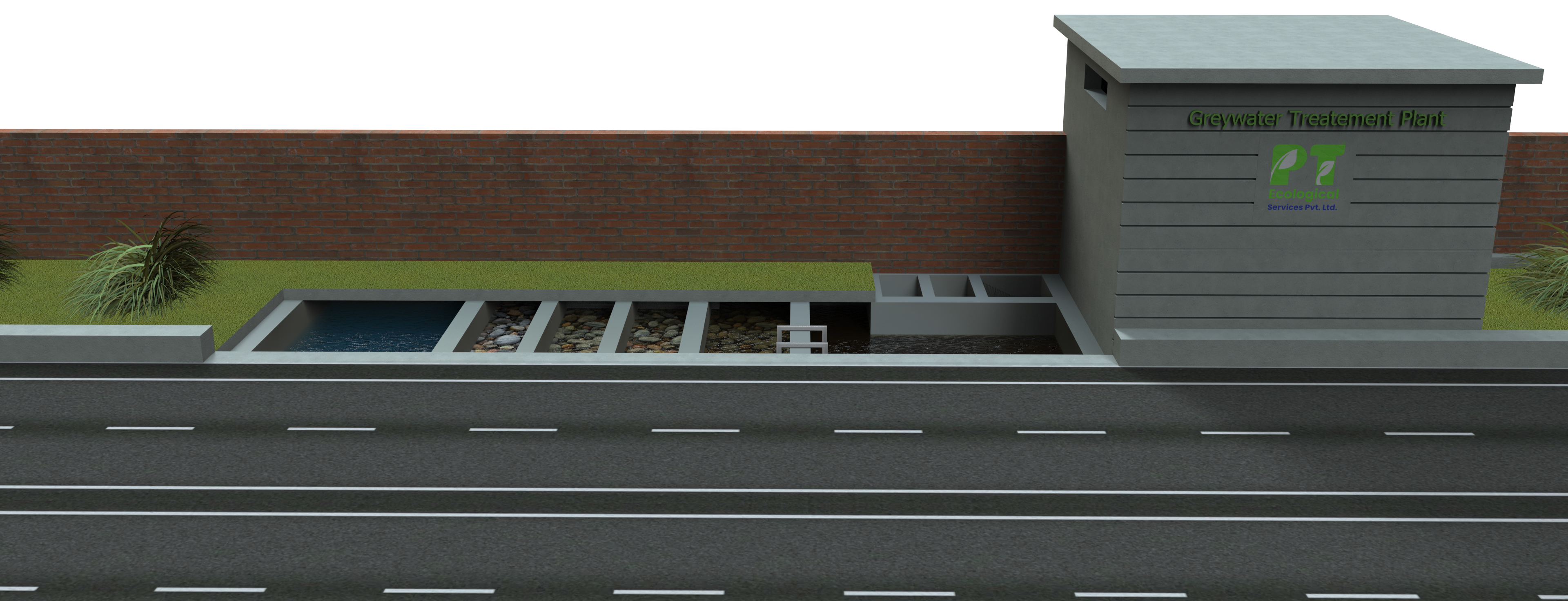
Grey Water Treatment Plant
Towards a Sustainable Future – Reuse. Recycle. Replenish.
Water scarcity is a growing global concern—with only 1.02% of the Earth’s accessible water available for use. As populations rise and demand increases, sustainable water management is no longer optional—it’s essential.
Grey water, generated from household activities like bathing, laundry, and kitchen use, is less contaminated than black water (sewage) and holds tremendous potential for reuse in non-potable applications.
At PT Ecological Services, we offer advanced grey water treatment systems for residential, commercial, and industrial use—helping you save water, reduce utility costs, and meet compliance norms.

Importance of Grey Water Treatment – Why It Is Necessary
Water scarcity is a critical challenge worldwide, with less than 1.02% of Earth’s water available for direct use. In urban areas, the demand for water is growing exponentially due to population rise, industrial expansion, and rapid urbanization. Grey water—wastewater from showers, sinks, laundry, and kitchens—makes up a significant portion of daily water usage and, when treated properly, can be safely reused for non-potable purposes such as landscaping, toilet flushing, and cooling towers.Why Grey Water Treatment Is Essential:
- Conserves Freshwater Resources – Reduces dependency on municipal water supply.
- Lowers Utility Costs – Enables cost-effective water reuse within residential, commercial, and industrial setups.
- Prevents Water Pollution – Treating grey water before discharge protects soil and groundwater quality.
- Meets Regulatory Requirements – Compliance with building codes and environmental regulations is mandatory for many projects.
- Supports Sustainability Goals – Promotes responsible water management and eco-friendly infrastructure.
Why Choose PT Ecological Services for Your Grey Water Treatment Plant?
At PT Ecological Services, we deliver innovative, customized grey water treatment solutions designed to meet your operational, environmental, and regulatory needs. Our expertise ensures efficient, reliable, and future-ready systems.Why We’re the Right Choice:
- Regulation-Compliant Designs – We build systems that adhere to UDCPR (Maharashtra Section 13.4), Environmental Guidelines, and other water conservation standards.
- Sustainable & Cost-Efficient Solutions – Our advanced systems minimize energy usage and operational expenses while maximizing water recovery.
- Tailored Systems for All Sectors – We provide solutions for residential complexes, commercial buildings, industrial facilities, and smart cities.
- End-to-End Expertise – From design and installation to automation, training, and AMC, we manage the complete lifecycle of your grey water system.
- Future-Ready Infrastructure – Our systems are engineered with cutting-edge technology, ensuring long-term reliability and scalability.
Why Choose PT Ecological’s Grey Water Treatment Plant?
Legal Compliance Meets Sustainable Innovation
In today’s regulatory landscape, efficient water management is a legal requirement. PT Ecological provides cutting-edge, regulation-compliant grey water treatment solutions that:- Reduce environmental impact
- Lower operational costs
- Ensure long-term legal compliance
Built to Meet All Major Regulatory Norms
Our systems are engineered to align with:- Unified Development Control & Promotion Regulations (UDCPR), Maharashtra – Section 13.4
- Environmental and Water Conservation Guidelines for Urban Development Projects
By partnering with PT Ecological, you’re not just treating grey water—you’re embracing sustainability, ensuring compliance, and building future-ready infrastructure.
Main Sources of Greywater
Greywater is wastewater generated from daily domestic or commercial activities that does not contain sewage or industrial effluents. It is less contaminated than blackwater and can be treated and reused effectively.Common Sources Include:
- Bathrooms – Water from sinks, showers, and bathtubs used for personal hygiene.
- Showers & Bathtubs – Greywater collected during bathing.
- Washbasins & Sinks – Wastewater from handwashing, shaving, and light cleaning.
- Laundry Areas – Discharge from washing machines and utility sinks used in cleaning clothes or linen.
Why Grey Water Treatment?
- Reduces water bills: Treating grey water helps save money on water bills by reusing water for secondary purposes like irrigation and flushing toilets.
- Conserve water resources: Grey water treatment preserves precious water resources by recycling water that would otherwise be wasted.
- Reduction of water pollution: By treating grey water before disposal, we can reduce the amount of pollutants entering water bodies, thus mitigating water pollution.
- Reduces the expense of building new water supply and wastewater treatment infrastructure: Investing in grey water treatment systems can lower the need for constructing new water supply and wastewater treatment facilities, saving significant costs.
- Decreases demand for sewage transport, treatment, and disposal: Properly treated grey water reduces the burden on sewage systems, leading to lower demands for transportation, treatment, and disposal of sewage.
- Compliance with regulations: Grey water treatment is required by regulations such as the “unified development control and promotion regulations for Maharashtra state” section 13.4, ensuring legal compliance and environmental responsibility.
Why Grey Water Treatment?
- Reduces water bills: Treating grey water helps save money on water bills by reusing water for secondary purposes like irrigation and flushing toilets.
- Conserve water resources: Grey water treatment preserves precious water resources by recycling water that would otherwise be wasted.
- Reduction of water pollution: By treating grey water before disposal, we can reduce the amount of pollutants entering water bodies, thus mitigating water pollution.
- Reduces the expense of building new water supply and wastewater treatment infrastructure: Investing in grey water treatment systems can lower the need for constructing new water supply and wastewater treatment facilities, saving significant costs.
- Decreases demand for sewage transport, treatment, and disposal: Properly treated grey water reduces the burden on sewage systems, leading to lower demands for transportation, treatment, and disposal of sewage.
- Compliance with regulations: Grey water treatment is required by regulations such as the “unified development control and promotion regulations for Maharashtra state” section 13.4, ensuring legal compliance and environmental responsibility.
Technologies We Offer
1. Mechanical Filtration & Reuse System
A compact, multi-stage process for efficient greywater recovery.
- Multi-Stage Filtration: Captures sediments, lint, and hair
- Clog-Prevention Design: Enhances system durability and flow
- Safe Reuse Output: Ideal for flushing, gardening, and landscaping
2. Continuous Water Biotechnology (CWBT)
A nature-inspired, low-maintenance biological treatment system.
- Phosphorus Removal: Prevents algae growth and water pollution
- Nitrogen Removal: Improves water quality for safe reuse
- Low-Chemical Operation: Supports sustainable, eco-friendly treatment
Technologies We Offer
Mechanical Filtration & Reuse System
A robust multi-stage treatment process designed for safe and efficient water recovery:
- Multi-Stage Filtration: Removes sediments, lint, and hair
- Sediment Separation: Prevents clogging, improving system longevity
- Advanced Purification: Delivers water safe for irrigation, flushing, and landscaping
- Eco-Reuse Applications: Ideal for sustainable non-potable water use
Continuous Water Biotechnology (CWBT)
A nature-based solution using bioreactors and anaerobic processes:
- Phosphorus Removal: Prevents eutrophication and algae growth
- Nitrogen Removal: Enhances water quality for safe reuse
- Low-Chemical Operation: Promotes natural water cycle restoration
1. Mechanical Filtration & Reuse System
A compact, multi-stage process for efficient greywater recovery.
- Multi-Stage Filtration: Captures sediments, lint, and hair
- Clog-Prevention Design: Enhances system durability and flow
- Safe Reuse Output: Ideal for flushing, gardening, and landscaping
2. Continuous Water Biotechnology (CWBT)
A nature-inspired, low-maintenance biological treatment system.
- Phosphorus Removal: Prevents algae growth and water pollution
- Nitrogen Removal: Improves water quality for safe reuse
- Low-Chemical Operation: Supports sustainable, eco-friendly treatment
Application Areas
Our Grey Water Treatment Plants are suitable for a wide range of environments, including:
- Residential Complexes & Societies
- Commercial Buildings & Offices
- Industrial Facilities
- Hotels & Resorts
- Hospitals & Healthcare Facilities
- New Construction & Green Building
- Projects like LEED, IGBC, and GRIHA
Key Benefits of Grey Water Treatment
- Regulatory Compliance: Ensures adherence to environmental standards like UDCPR and local norms.
- Lower Water Bills: Reuses grey water for non-potable applications like toilet flushing and gardening, reducing utility costs.
- Freshwater Conservation: Minimizes dependence on scarce freshwater sources by recycling used water.
- Infrastructure Savings: Reduces the need for expanding water supply and sewage treatment infrastructure.
- Pollution Control: Prevents untreated grey water from polluting rivers, lakes, and groundwater.
- Reduced Sewage Load: Decreases the burden on municipal sewage systems and treatment plants.
FAQ
Grey water is lightly used water from showers, sinks, and laundry; black water contains sewage and requires more intensive treatment.
Yes, when properly treated, it can be safely reused for flushing, gardening, and cooling towers.
Yes, in many regions like Maharashtra (UDCPR), it is a regulatory requirement for new constructions.
Properly designed and maintained systems prevent odor and clogging using multi-stage filtration and biological processes.
Properly designed and maintained systems prevent odor and clogging using multi-stage filtration and biological processes.
Absolutely, reuse systems contribute points under LEED, IGBC, and GRIHA certifications.
Most systems can be installed within 7–15 days, depending on project scale and site readiness.
Yes, modular designs make retrofitting feasible without major civil changes.
The system self-adjusts to flow variation, and excess can be directed to the STP or bypass safely.
Space-saving solutions like Mechanical Filtration Units and CWBT modules are designed for compact areas and can be installed in basements, terraces, and utility rooms.
Grey water is lightly used water from showers, sinks, and laundry; black water contains sewage and requires more intensive treatment.
Yes, when properly treated, it can be safely reused for flushing, gardening, and cooling towers.
Yes, in many regions like Maharashtra (UDCPR), it is a regulatory requirement for new constructions.
Yes, in many regions like Maharashtra (UDCPR), it is a regulatory requirement for new constructions.
Properly designed and maintained systems prevent odor and clogging using multi-stage filtration and biological processes.
Properly designed and maintained systems prevent odor and clogging using multi-stage filtration and biological processes.
Absolutely, reuse systems contribute points under LEED, IGBC, and GRIHA certifications.
Most systems can be installed within 7–15 days, depending on project scale and site readiness.
Yes, modular designs make retrofitting feasible without major civil changes.
The system self-adjusts to flow variation, and excess can be directed to the STP or bypass safely.
